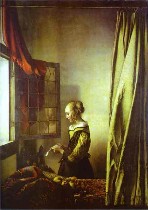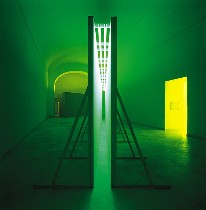Post by Mark Shetabi
 Artists of the Baroque didn’t leave many letters behind for fear of a paper trail leading to something like a Clear Channel boycott or worse.
Artists of the Baroque didn’t leave many letters behind for fear of a paper trail leading to something like a Clear Channel boycott or worse.
I think that the interiority of Baroque painting (Vermeer’s “Girl Reading Letter shown) was in part a reaction to the fear of being watched.
The rather tense atmosphere of the Baroque echoes our own times. Many artists today seem very hesitant to express an opinion on events that happen outside their studios.
This is not necessarily a criticism of the artists, as there is still a lot of great work being made.
Rather, it is an observation that the public square seems to be getting smaller and there is an idea that people ought to leave the heavy thinking to the experts.
 Artists should stick to paint, doctors should talk tumors and leave war and peace to the political set. Good-looking actors shouldn’t discuss deforestation or Third World debt relief on Letterman (shown Jane Fonda in Vietnam).
Artists should stick to paint, doctors should talk tumors and leave war and peace to the political set. Good-looking actors shouldn’t discuss deforestation or Third World debt relief on Letterman (shown Jane Fonda in Vietnam).
This is why things like the Michael Moore’s Oscar speech or Natalie Maine’s comments on the president arouse so much antipathy. Inevitably it will seem crude and clumsy to inject prickly issues like war and pre-emption into art.
 On the other hand, a lot of contemporary visual culture borrows heavily from the Baroque and along with the formal tricks, artists seem to have picked up on the undercurrent of control and privacy that the art evokes (shown, Bruce Nauman’s “Green Light Corridor”). The Baroque seems more relevant for good reason.
On the other hand, a lot of contemporary visual culture borrows heavily from the Baroque and along with the formal tricks, artists seem to have picked up on the undercurrent of control and privacy that the art evokes (shown, Bruce Nauman’s “Green Light Corridor”). The Baroque seems more relevant for good reason.
Today we are surrounded by the technology that Enlightenment thinking brought about, but we are once again living in a society dominated by Baroque surveillance and fear. The U.S. pre-emptive doctrine is based on surveillance.
 We have grown used to the idea that being observed is a natural payoff to being in public(shown, Ozzie Osborne and family). Our public spaces are designed in part to make surveillance easier. Surveillance seems almost comforting to many.
We have grown used to the idea that being observed is a natural payoff to being in public(shown, Ozzie Osborne and family). Our public spaces are designed in part to make surveillance easier. Surveillance seems almost comforting to many.
It certainly imposes order. People tend to behave better when they are watched.
Artists grow up in the same soil as other people, watch the same television and breathe the same air. It’s only natural that some will notice these things
and make art out of it.
— 2002 Pew Fellow in the Arts Mark Shetabi showed this year at White Columns in New York and at Locks Gallery, here in Philadelphia









